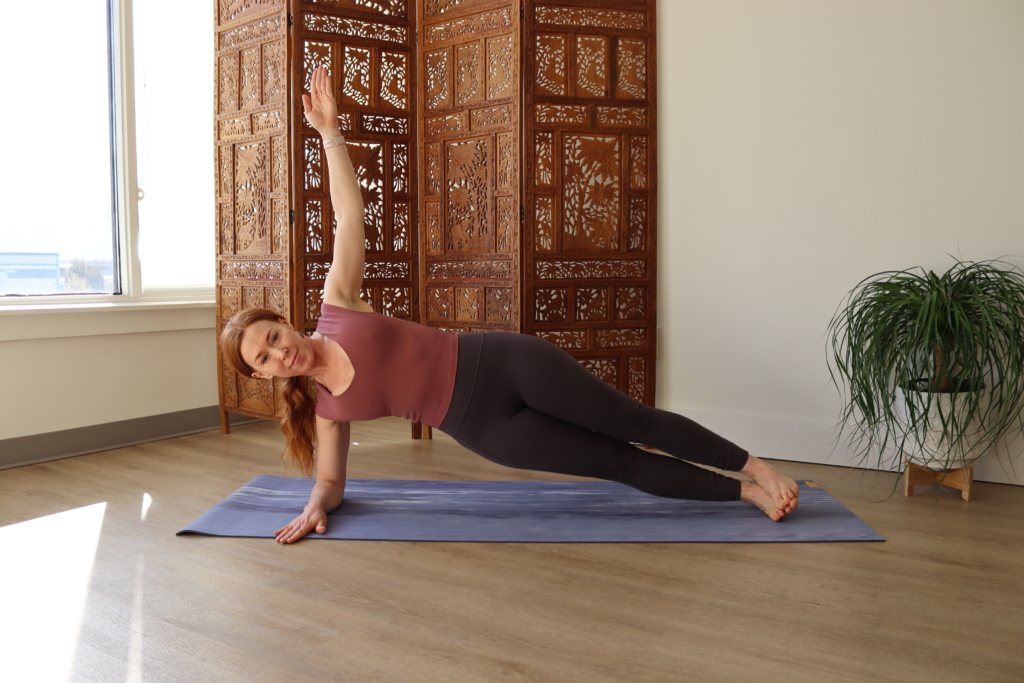
[ad_1]
This entry was posted on Jun 12, 2024 by Charlotte Bell.

Do you apply Facet Plank Pose (Vasisthasana)? I’ll admit that it hasn’t at all times been part of my common apply routine. That’s as a result of, properly, it’s exhausting. However it’s additionally as a result of, in recent times, I’ve discovered that the “full” model of the pose will not be so nice on my arms and wrists.
As an instrumentalist (oboe and English horn), I can solely accomplish that many Downward Going through Canine Pose-Upward Going through Canine Pose-Chaturangas earlier than I really feel that my arms and wrists have had sufficient. The identical is true for Vasisthasana. Previously, I’ve prevented the pose altogether, as a result of I want to avoid wasting my arms and wrists for enjoying music. Nonetheless, one easy variation permits me to glean the advantages of Vasisthasana with out compromising my arms and wrists.
If you wish to know extra in regards to the conventional model of Vasisthasana, take a look at this submit. It additionally consists of an attention-grabbing rationalization of the mythology behind the Facet Plank’s Sanskrit title.
Why Follow Facet Plank?
Facet Plank confers so many advantages. Its strengthening energy is very essential for flexible practitioners.
- Strengthens your abdominals: Facet Plank Pose strengthens your core and backbone. The pose concurrently engages the rectus abdominius, transverse abdominus and obliques.
- Strengthens low again and hip muscular tissues: Facet Plank strengthens the muscular tissues in your decrease again and hips. Hip and again ache are sometimes attributable to weak muscular tissues in these areas. Whereas crunches and situps are better-known methods to strengthen your abdominals, Vasisthasana, not like crunches and situps, strengthens the abs with out placing strain on the muscular tissues of the low again.
- Strengthens the higher physique: Vasisthasana additionally strengthens your shoulders, wrists (within the conventional model), and arms.
- Improves steadiness: Facet Plank is a balancing pose, so it helps you domesticate your balancing expertise. Along with the problem of balancing on one hand (or arm) and one foot, we’re additionally balancing with our heads in a horizontal place. This helps stimulate the vestibular system, which is concerned in steadiness and proprioception.
Facet Plank Contraindications
Like each different yoga pose, Facet Plank Pose will not be for everybody always. If you’re experiencing any of the next circumstances, you must apply with care or keep away from Vasisthasana altogether:
- Hypertension, migraines, rheumatoid arthritis or any cardiovascular circumstances
- Current stomach surgical procedure
- Being pregnant, particularly within the first trimester
- Energetic accidents to the hips, again, ankles, shoulders or neck
- This contraindication is considerably uncommon. Facet Plank could cause rib displacement. In case your physique isn’t susceptible to displaced ribs, working towards it shouldn’t be an issue. However some further flexible individuals undergo this tendency, which is kind of painful. It that is you, keep away from working towards Facet Plank.
- In the event you really feel ache wherever when you’re within the pose, depart the pose.
How you can Follow Vasisthasana Variation
- Lie in your proper aspect on a Yoga Mat.
- Place your proper forearm, palm aspect down, in your mat, perpendicular to your physique. Your elbow ought to be proper below your shoulder, and your head, shoulders and chest can be angled away from the ground. Go away the appropriate aspect of your pelvis in your mat.
- Stack your left foot on high of your proper foot.
- Now press down together with your proper arm to carry your torso and legs off the mat.
- You’ll be able to both prolong your left arm up towards the sky, or depart your left hand in your left hip.
- Keep away from letting your pelvis sag down. Use the again and core muscular tissues of your proper aspect to carry the pelvis so your physique is in a straight, diagonal line.
- Loosen up your head, trying straight forward reasonably than making an attempt to lookup towards the ceiling, which will be exhausting in your neck.
- Take 5 to 10 deep breaths. You may also set a timer for 20 to 30 seconds, after which construct the period of the pose over months.
- Launch your physique again right down to the ground, persevering with to assist your self together with your forearm. This enables the appropriate aspect of your physique to obtain a delicate stretch.
- Follow your different aspect.
About Charlotte Bell
Charlotte Bell found yoga in 1982 and commenced educating in 1986. Charlotte is the creator of Conscious Yoga, Conscious Life: A Information for On a regular basis Follow and Yoga for Meditators, each revealed by Rodmell Press. Her third guide is titled Hip-Wholesome Asana: The Yoga Practitioner’s Information to Defending the Hips and Avoiding SI Joint Ache (Shambhala Publications). She writes a month-to-month column for CATALYST Journal and serves as editor for Yoga U On-line. Charlotte is a founding board member for GreenTREE Yoga, a non-profit that brings yoga to underserved populations. A lifelong musician, Charlotte performs oboe and English horn within the Salt Lake Symphony and folks sextet Pink Rock Rondo, whose DVD gained two Emmy awards in 2010.
[ad_2]